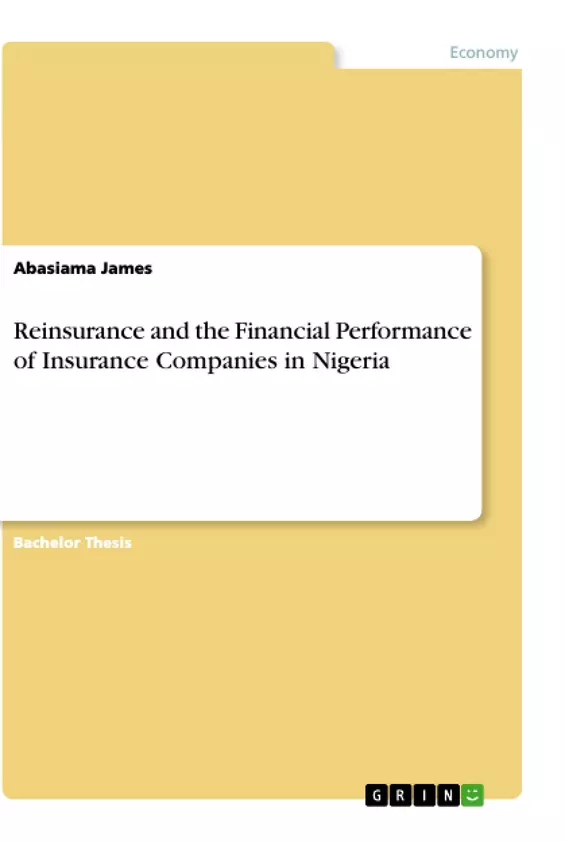This study explores the effects of reinsurance arrangements on financial performance of insurance companies in Nigeria. It is worthy of note that insurance companies are exposed to a harsh environment once engaged in high-level risk taking that have the potentials to weaken their financial ability to settle claims and mostly threaten their survival. Hence, it is a known fact that reinsurance arrangement can provide some level of financial protections for insurers against the risk of their own default.
In particular, the study assessed the effect of reinsurance utilization on underwriting profit, gross premium incomes and gross claim payments of insurance companies in Nigeria. Secondary data was collected from 32 licensed insurance firms who have reinsurance coverage out of the 42 registered insurance companies in Nigeria. The study used expo facto research design and data were gathered from published annual reports of NAICOM, insurers' annual financial reports and NIA digests from 2009-2018.Both descriptive and inferential statistics of OLS were employed in analyzing the data.
Inhaltsverzeichnis (Table of Contents)
- CHAPTER ONE.
- INTRODUCTION
- Background of the Study
- Statement of the Problem
- Objectives of the Study
- Research Question
- Hypotheses
- Significant of the Study
- Scope/Limitation of the Study
- Operational Definition of Terms
- CHAPTER TWO
- LITERATURE REVIEWS
- Introduction
- Conceptual Reviews
- Theoretical Reviews
- Empirical Reviews
- CHAPTER THREE.
- RESEARCH METHODOLOGY
- Introduction
- Research Design
- Population
- Sample
- Sampling Technique
- Types and Source of Data
- Variable Operationalization
- Model Specification
- Method of Analysis
- Econometrics Issues
- CHAPTER FOUR.
- Introduction
- Data Presentation
- Descriptive Data Analysis
- Test of Hypotheses
- Discussion of Findings
- CHAPTER FIVE
- SUMMARY, CONCLUSION AND RECOMMENDATIONS
- Introduction
- Summary
Zielsetzung und Themenschwerpunkte (Objectives and Key Themes)
This research project aims to explore the impact of reinsurance arrangements on the financial performance of insurance companies in Nigeria. The study investigates how reinsurance utilization influences key financial indicators such as underwriting profit, gross premium incomes, and gross claim payments.
- The role of reinsurance in mitigating risk and enhancing financial stability for insurance companies
- The impact of reinsurance on underwriting profitability and premium income generation
- The relationship between reinsurance and the ability of insurance companies to settle claims efficiently
- The impact of reinsurance on policyholder confidence and overall financial performance
- The role of regulatory bodies in promoting reinsurance adoption and ensuring the financial health of the insurance sector in Nigeria
Zusammenfassung der Kapitel (Chapter Summaries)
- Chapter 1: Introduction introduces the research problem, stating the importance of reinsurance arrangements in mitigating risks faced by insurance companies. It outlines the objectives, research questions, and hypotheses of the study, highlighting the significance of the study in improving the financial performance and stability of the Nigerian insurance industry.
- Chapter 2: Literature Reviews explores the theoretical and empirical literature on reinsurance, providing a comprehensive overview of the key concepts, models, and research findings relevant to the study. This chapter establishes the context for the research and highlights the existing knowledge gap that the study aims to address.
- Chapter 3: Research Methodology outlines the research design, population, sample, sampling technique, data sources, variable operationalization, and data analysis methods employed in the study. This chapter provides a detailed description of the research approach, ensuring transparency and replicability of the study.
- Chapter 4: Data Presentation and Analysis presents the collected data, conducts descriptive analysis, and tests the hypotheses formulated in Chapter 1. This chapter provides a comprehensive analysis of the data and examines the relationship between reinsurance utilization and the financial performance of insurance companies in Nigeria.
Schlüsselwörter (Keywords)
This research delves into the impact of reinsurance arrangements on the financial performance of insurance companies in Nigeria. The core concepts explored include reinsurance utilization, underwriting profit, gross premium income, gross claim payments, financial stability, risk management, and the role of regulatory bodies in the Nigerian insurance sector. These concepts are examined through the lens of financial indicators and data analysis techniques, providing insights into the effectiveness of reinsurance as a risk management strategy for insurance companies in Nigeria.
- Citation du texte
- Abasiama James (Auteur), 2021, Reinsurance and the Financial Performance of Insurance Companies in Nigeria, Munich, GRIN Verlag, https://www.grin.com/document/1021706



